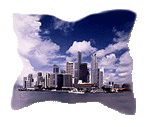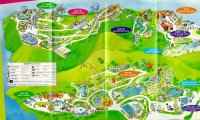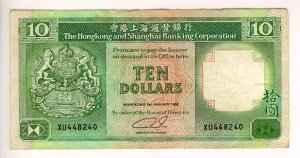












|
 |


This should be the most interesting city in the world at the time: Hong Kong. The name of the city emerge from the Englishmen who came to the island in the 1840s and their interpretation of the Cantonese name of the island. The name in Mandarin Chinese (putong hua) is Xiang1 Gang3.
In August 1996 I went to Hong Kong and spent two weeks of my vacation there. It was a great experience and one of the most exiting things I ever done. Everything is so different from my home country Sweden. I took a lot of pictures and here follows a presentation of Hong Kong.
Hong Kong, Chinese Special Administrative Region (SAR), is made up of 234 islands, a portion of the mainland, and a considerable expanse of water surface. It has a land area of 1076 sq km (415 sq mi). Despite its small size, Hong Kong plays an important role in the world economy.
Geography
The dependency can be divided into three main regions-Hong Kong Island and nearby islets; the mainland Kowloon Peninsula and Stonecutters Island; and the New Territories, made up principally of a large area on the mainland and Lantau island. The dependency is partly situated in the Zhu Jiang, or Pearl River, delta, and the Sham Chun River forms the border with mainland China. Much of Hong Kong is hilly, and substantial areas of the low-lying terrain are made up of land reclaimed from the sea. Only about 12 percent is forested, but small tropical and subtropical plants are abundant elsewhere. Hong Kong's small amount of fertile soil is concentrated in the mainland portion of the New Territories, near Deep Bay. Few large wild animals inhabit the dependency.
People and Principal Cities
The population of Hong Kong is (1995 official estimate) of 6,189,800. Of them are about 97 percent Chinese, with some Filipinos (106 000), British (22 000), Indians (19 000), Japanese (15 000), and Americans (27 000). The population of Hong Kong is approx 6,2 million. The overall population density is 5,753 people per sq km (14,915 per sq mi), making Hong Kong one of the most densely populated regions in the world.
Chinese culture dominates in Hong Kong. Yet, as a port inhabited and visited by people of many nationalities, the dependency is subject to diverse influences, especially that of the British. Most people adhere to a version of the Chinese folk religion, which combines elements of Buddhism, Confucianism, Taoism, and other beliefs. About 8 percent of the people are Christian.
The capital and cultural center of Hong Kong is Victoria, which is on the northern shore of Hong Kong Island. Also of major importance are Kowloon and New Kowloon, extending from the Kowloon Peninsula into the New Territories. Kowloon and Victoria are separated from each other by Victoria Bay.
Foreign Trade
In the post-war period Hong Kong has grown to be one of the world's major manufacturing, trade, and financial centres, expanding its traditional entrepôt role through considerable investment in industry. It also serves as a major channel for trade and investment in mainland China, and has been increasing its economic interests in the mainland as the economy there expands and with the reversion to Chinese sovereignty in 1997. In 1995 Hong Kong's imports (c.i.f. value) were valued at US$177 billion and its exports and re-exports at US$195 billion. The estimated budget for the fiscal year 1994-1995 included income of US$19 billion and expenditure of US$14.1 billion, yielding a budget surplus of US$4.9 billion. Major exports were clothing, textiles, timepieces, toys, electrical machinery, and computer and other electronic components. Hong Kong's principal trade partners are China, Japan, Germany, Taiwan, the United States, Singapore, South Korea, Canada, and Great Britain. Much foreign exchange comes from the expenditures of the more than 6 million tourists who visit Hong Kong each year.
Government
Until July 1997, as a dependency of the United Kingdom, Hong Kong was governed with guidance from London, in the same manner as other British-controlled territories worldwide. After the signing of the first Sino-British Joint Declaration in 1984, democratic representation was gradually extended through Hong Kong. Its political structure remained in place until the handover of sovereignty to mainland China in 1997. At this point, China installed its own governing apparatus, in accordance with Hong Kong's new status as a Special Administrative Region of China.
Executive
Paramount military and civil authority under British rule was vested in an appointed British governor-general representing the Crown. The governor presided over and was assisted by the 13-member Executive Council, three of whom were ex-officio members and the rest appointed by the governor. The supreme executive authority after the handover was vested in a chief executive, chosen by a 400-strong Selection Committee, governing with an Executive Council appointed by the Executive.
 Legislature
Legislature
Hong Kong's legislative organ prior to July 1997 was the 60-member Legislative Council (Legco), 39 of whom were, by 1995, directly elected (20 by public poll, 10 by electoral colleges, and 9 by functional constituencies representing occupational groups), and 21 indirectly elected. This replaced the system in force until 1995 in which 18 members were appointed by the governor. The mainland Chinese government, antipathetic towards this elected legislature, declared its intention in March 1996 to scrap the Legislative Council and replace it with a 60-member assembly chosen by China's Selection Committee. This body was nominated in December 1996 and began meeting in Shenzhen. However, China promised open elections to a new Legislative Coucil in 1998.
Judiciary
Hong Kong law is mostly derived from British law, though by 1997 most important legislation was replaced by that derived from the Legislative Council. The highest tribunal of the dependency is the Supreme Court, divided into the Court of Appeal and the High Court. Lower courts include district courts, magistrates' courts, a coroner's court, a juvenile court, and sundry tribunals. The structure of the legal system after the handover to Chinese rule in 1997 was one of the most contentious points of Sino-British negotiations, with China drawing up 25 new laws and articles in January 1997 which were condemned by Britain as injurious to human rights.
Local Government and Political Parties
Elected municipal councils, the Urban Council (for central Hong Kong) and Regional Council (for the New Territories), administer local matters. Until 1995 a minority of their members were appointed. There are also consultative district boards in all districts. Political parties sprang up in Hong Kong after the introduction of direct elections. The first political party to be formed, in 1990, was the United Democrats of Hong Kong, followed by other pro-democracy parties. The future of these groupings under Chinese rule is uncertain. The parties closest to the Communist government of China are the Democratic Alliance for the Betterment of Hong Kong and the Liberal Party.

Map of Ocean Park (56kb)
History
Before the British occupation, Hong Kong had a small fishing community and was a haven for pirates and opium smugglers. Britain first used the island as a naval base during the Opium Wars with China. By the Treaty of Nanjing in 1842, which ended the First Opium War, Hong Kong was ceded to the British in perpetuity. After a second conflict in 1860, Great Britain acquired Kowloon and Stonecutters Island and in 1898 obtained the New Territories under a 99-year lease.
Hong Kong became a refuge for political exiles from the mainland of China following the establishment of the Chinese Republic in 1912. Ensuing Chinese nationalism was marked by antagonism toward all foreign countries, and a Chinese boycott from 1925 to 1927 denied British shipping access to the ports of southern China.
When Japan seized Manchuria in 1932 and the Sino-Japanese War broke out in 1937, China turned to Great Britain and other European countries for its military supplies, and diplomatic relations between the British in Hong Kong and the Chinese became friendlier. Throughout 1937 hundreds of thousands of Chinese, displaced by the Japanese invasion of their country, sought refuge in Hong Kong. Meanwhile, Great Britain began strengthening the colony's defenses.
The outbreak of World War II in September 1939 further dislocated the economic life of Hong Kong, already seriously affected by the Sino-Japanese conflict. The threat of Japanese aggression also grew steadily. Japanese aircraft bombed Kowloon on December 8, 1941, and ground forces dislodged British troops from Kowloon and the New Territories; the British surrendered on December 25. Having occupied Hong Kong, the Japanese converted it into a military bastion and supply station for their projected campaigns in East Asia. Their operations were largely hampered, however, by U.S. submarines and bombing planes. The British reoccupied Hong Kong following the unconditional surrender of Japan on August 14, 1945.

Hong Kong After World War II
Hong Kong swiftly regained its status as a major southeast Asian trade center. Numerous economic dislocations resulted, however, from the Nationalist-Communist civil war in China. Hundreds of thousands of Chinese took refuge in the colony before and after the Communist victory in 1949. Following the ban imposed by the United States on trade with Communist China in 1950, the commercial activity of Hong Kong declined. The colony had to use its own resources to develop new industries.
Thousands of newly arrived Chinese from the mainland provided labor and money for the rapid growth of light manufacturing industry during the 1950s and 1960s. In this period, also, the liberal tax policies of the government attracted foreign investment. The resultant economic boom transformed Hong Kong into one of the wealthiest and most productive areas in southeast Asia. Communist-led riots raged throughout the spring and summer of 1967 and temporarily threatened the political stability of the colony. In the mid-1970s the flow of refugees from the mainland increased. Relations, however, remained friendly, and commercial ties with the Chinese prospered with the initiation in the early 1980s of a number of joint economic ventures.
Impending Reversion to China
With the British lease on the New Territories due to expire in 1997, talks between China and Great Britain over Hong Kong's future began in 1982. A legally binding agreement reached between the countries in September 1984 and signed in Beijing in December, the Sino-British Joint Declaration, stipulated that all Hong Kong would revert to Chinese sovereignty in 1997. The territory, which would at that time become known as the Hong Kong Special Administrative Region of China, would be allowed to maintain its own legal, social, and economic systems for at least another 50 years, and civil liberties would be guaranteed. China would assume responsibility for foreign affairs and defence. A committee was convened in Beijing, including representatives from Hong Kong, to draft the Basic Law (constitution) for Hong Kong after 1997. Great Britain increased limits on the nationality status of Hong Kong citizens to remove right of abode in Britain after 1997. In 1985 the Legislative Council (Legco) was expanded and indirect elections to it on a very limited franchise were held for the first time.
Sino-British Relationship
Relations between China and the United Kingdom over Hong Kong deteriorated during 1991, due to disputes over financing of the airport project and Chinese demands to be consulted. The United Democrats and their allies won 17 of the 18 seats on the Legislative Assembly contested in the September 1991 elections, though on a relatively low turnout. In May 1992 the Hong Kong government began the forcible repatriation of all Vietnamese refugees classed as "economic migrants". On June 1, 2000, authorities in Hong Kong closed down the last remaining Vietnamese refugee camp in the former British colony. Some 200,000 Vietnamese boat people spent time in Pillar Point camp and other centres located on islands and other remote areas, in the wake of the defeat of South Vietnam by the Communist North in 1975. In July 1992 Chris Patten was appointed Governor of Hong Kong, and in October he presented plans for extension of direct democracy through broadening of functional constituencies within the Legco franchise. China denounced the proposals as contravening all previous agreements and in November suspended talks on the airport project, threatening to cancel all contracts related to it in 1997.
The reform proposals were passed by the Executive Council in February 1993, but their presentation to Legco was suspended to allow negotiations with China on the subject. In July, China established a government-in-waiting for Hong Kong in Beijing. Negotiations reopened, but after protracted Chinese foot-dragging, the reforms were passed by the Legco in the first half of 1994, lowering the voting age from 21 to 18, establishing new functional constituencies with 2.5 million voters, replacing corporate voting by individual voting in other functional constituencies, and establishing council seats indirectly elected by the directly elected local councils. China announced that the reforms would be dismantled and the elected councils replaced after 1997. Agreement between the United Kingdom and China on funding the new airport was finally reached in November 1994. Democratic Party candidates and their allies soundly defeated candidates friendly to the mainland government in elections to the local councils in March 1995. In June agreement was finally reached between the UK and China on the form of the court of final appeal, to operate in the Hong Kong legal system after 1997.
| Contact and Feedback |
|




















